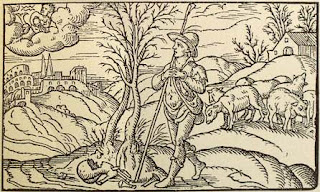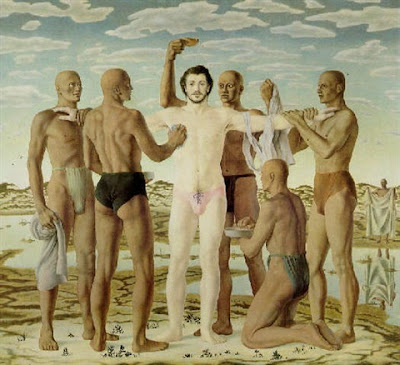Three Studies: Part 4 (of 7)

As already said, Seven Studies for a Self Portrait contains seven sections. The sections are of even lengths, apart from the seventh section which constitutes almost half of the book. The sections which follow “Seven Studies” expand in difficulty, opening to what is the tour de force among the short sequences: “Bull Eclogues”. There is an enigmatic quality to “Seven Studies”. And this is followed by three further puzzles. These sequences could be compared to musical studies, short pieces that create a single mood or mode of expression. The best musical parallel I can think of would be the piano studies of Satie, at once mystical, poised, and singular— but whereas Satie can become eccentric, Jee Leong Koh is elliptical.
The title “Profiles” immediately suggests an ambiguity. A profile is a short description and a figure painted from the side. Each of the poems in “Profiles” describes a “He”, an unknown man viewed in miniature and from a side-view. The poems are oblique shots of human lives. In some ways, the poems also seem distanced by time. The controlled free verse, which is actually the most relaxed poetry in the volume, creates a sedative atmosphere (reminiscent of Cavafy), one in which imperfect lives exist, without any real identity, without any real guilt.
The sequences “I Am My Names” and “What We Call Vegetables” use a rigid metric. The poems in “What We Call Vegetables” are still-life drawings. They peel open, revealing fragments of the body/self. The poems in “I Am My Names” sketch 7 characteristics of the author: son, lover, poet, homosexual, Singaporean, Chinese, father, in the sense of ghazal 42, “Deep in your words, you realise you are your own father”. These are exquisite reflections on fractions of the whole self.
In “Translations of An Unknown Mexican Poet”, Jee Leong Koh has created a substantial personae poem. Originally published in PN Review as six poems, SSfaSP re-instates “Pigeons” to its justified place. It is a sequence about “giving style” and finding identity. The original poet has no name. He is a person removed from knowing. He is known in his work, but he is removed from this also: it is to be experienced in English. The sequence amounts to an interesting game about what can be known in poetry. Translations are a significant part of the poetry world. Every translator is involved a battle between meaning and technique, how to convey both, when to accept that only one aspect will carry over. And every compromise is a step away from the identity that created the original. It is interesting that the sequence opens with the threat of death, "I'm going to kill myself unless the day lets me in" (SSfaSP, p.51) because in one sense the poet has already died and passed from memory into death, the unknown, but is being brought back to life. What does exist of any author in what they write? That depends on the school of criticism followed!
The title “Profiles” immediately suggests an ambiguity. A profile is a short description and a figure painted from the side. Each of the poems in “Profiles” describes a “He”, an unknown man viewed in miniature and from a side-view. The poems are oblique shots of human lives. In some ways, the poems also seem distanced by time. The controlled free verse, which is actually the most relaxed poetry in the volume, creates a sedative atmosphere (reminiscent of Cavafy), one in which imperfect lives exist, without any real identity, without any real guilt.
The sequences “I Am My Names” and “What We Call Vegetables” use a rigid metric. The poems in “What We Call Vegetables” are still-life drawings. They peel open, revealing fragments of the body/self. The poems in “I Am My Names” sketch 7 characteristics of the author: son, lover, poet, homosexual, Singaporean, Chinese, father, in the sense of ghazal 42, “Deep in your words, you realise you are your own father”. These are exquisite reflections on fractions of the whole self.
In “Translations of An Unknown Mexican Poet”, Jee Leong Koh has created a substantial personae poem. Originally published in PN Review as six poems, SSfaSP re-instates “Pigeons” to its justified place. It is a sequence about “giving style” and finding identity. The original poet has no name. He is a person removed from knowing. He is known in his work, but he is removed from this also: it is to be experienced in English. The sequence amounts to an interesting game about what can be known in poetry. Translations are a significant part of the poetry world. Every translator is involved a battle between meaning and technique, how to convey both, when to accept that only one aspect will carry over. And every compromise is a step away from the identity that created the original. It is interesting that the sequence opens with the threat of death, "I'm going to kill myself unless the day lets me in" (SSfaSP, p.51) because in one sense the poet has already died and passed from memory into death, the unknown, but is being brought back to life. What does exist of any author in what they write? That depends on the school of criticism followed!



Comments